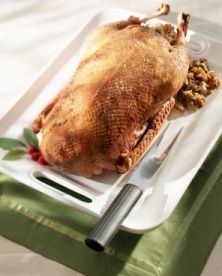 |
 |
 |
Traditional Irish Christmas recipes

Christmas in Ireland : marketsIn the 18th and 19th centuries, The Margadh Mor the Big Market kickstarted the countdown to Christmas in Ireland.Its alternative name the Live market was perhaps a better description because this is where the fowl (turkeys, goose, hens) were sold alive. In the third week, the Dead Market took place. You can work out why. At this market, too, were bought new clothes, whiskey, sweets, tobacco and all the ingredients for a Christmas pudding. The latter, which bears little resemblence to the modern Irish plum pudding, was boiled on Christmas Eve after the home had been decorated with laurel, holly and ivy.
Geese, ducks, great sides of beef, sheep and pork were turned on the roasting spit in the halls of chieftains in early Christian and medieval times. In later centuries, the spit had become the kitchen oven and, by the late 18th century, vegetables and fruits began to feature more heavily on the table during the Irish Christmas. Recipes using beef suet, mixed dried fruit and whiskey in cakes and puddings not terribly dissimilar to those that make an appearance on our modern festive tables every year started to acquire a seasonal status. Preparations began weeks in advance for these cakes and puddings.
So, too, did the slaughter of cattle and pigs. The latter were shared out with others. While the majority poor simply shared with their immediate family and neighbours, the traditional division among the gentry in the early 19th century was as follows:
To the gentry of Ireland, Christmas food meant enormous feasts of meats, fishes, vegetables, rich creamy sauces and all manner of sweet delicacies washed down with copious quantities of alcoholic refreshments. But to the majority of our ancestors, Irish Christmas recipes produced rather more hearty fare. While they were less rich than the foods enjoyed by those further up the social ladder, they were nonetheless exceptionally luxurious to the palate of a population that lived at subsistence level (or worse) for much of the year. The following are brief descriptions of typical Irish Christmas recipes still enjoyed today.
Roast Goose (25th December)
Although not confined to Ireland's Christmas dinner table, baked ham is another dish often served with the goose. Three types of potatoes are quite likely to appear with Christmas dinner: roast, boiled and mashed, plus roasted parsnips, boiled or mashed swede, brussels sprouts and cabbage.
 The goose Prepare the stuffing first (see below). Allow at least 1lb (450g) uncooked weight per diner. Assuming the goose is already gutted, you just need to wash and dry it and cut away any excess fat around the neck cavity. Prick the skin all over and rub it with lemon and seasoning. Season the main cavity with salt and freshly ground pepper and fill it with the cooled stuffing. Place the goose in a roasting tin and roast in a very hot oven 240C, 475F, gas 9, for ten minutes. Reduce the heat to 180C, 350F, Gas 4 and cook for 2-21/2 hours but remove the bird from the oven three of four times to pour off excess fat. If you don't do this, your goose will taste very greasy. To test whether cooked, prick the bird at the thickest part. When the juices run clear, Christmas dinner's centrepiece is ready. Apple & Potato Stuffing, for a 10lb (4.5kg) goose: Method:
Boil the potatoes in salted water. When cooked, mash without using milk or butter. Melt the butter into a pan and, over a low heat, fry the onions for five minutes without allowing them to brown. Add the apples and cook until they are softened. Stir in the mashed potatoes, parsley and balm. Season. Allow to cool before stuffing the goose.
Plum Pudding (25th December)
For a perfect dessert, follow this simple Irish Christmas recipe for plum pudding and accompaniments.
Spiced beef for St Stephen's Day Irish Spiced Beef is traditionally served on St Stephen's Day (26th December). This is the case in most of Ireland but in Co. Cork, Spiced Beef is not just one of the most popular Irish Chrismas recipes, it is also a dish served all year round. Although our ancestors would have prepared their own dish, and many families still do, you can find well-prepared beef joints, liberally covered in spices, in butchers throughout Ireland in the two weeks before Christmas. Ingredients: for 20-25 servings
To boil the beef, make a bed of carrots, turnips and ringed onions at the bottom of a pan. Place the beef on top, add the bay leaf, and cover with cold water. Boil for 30 minutes per 1lb/450g, plus an extra 30 minutes. Remove from pot and place between two plates. Put a heavy object on top of the plate and leave for 12-15 hours and then tie the beef with string. Mix the herbs and spices with salt, sugar and minced onion. Cover the meat in this mixture, rubbing it in well for several minutes. Place into an earthenware crock and cover. Turn the meat once a day, every day for a fortnight and rub in the spice mixture each time.
Scones for Little Christmas (6th January)
This tradition arose from the belief that women deserved a special day of their own after providing for their families throughout the festive period. The chosen foods were considered 'dainties' but Spiced Beef still often makes an appearance, too. These baked goodies are enjoyed throughout the year, not just as part of an old-fashioned homely Irish Christmas. Recipes for these traditional Irish foods can be found here.
| ||
|
|
||
|
| Home Page | Disclaimer | Contact |Sitemap|Privacy Policy|
By Claire Santry, Copyright©
2008-2020 Irish-Genealogy-Toolkit.com. Dedicated to helping YOU discover your Irish Heritage.
|
||